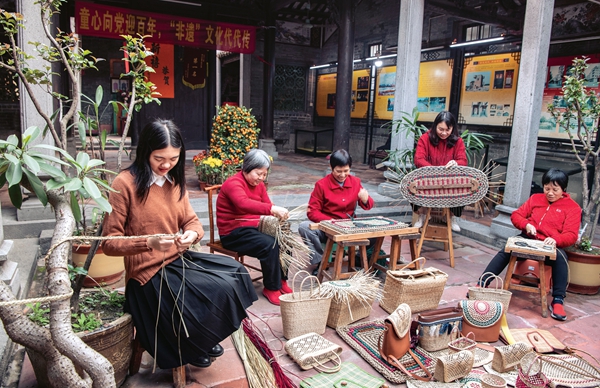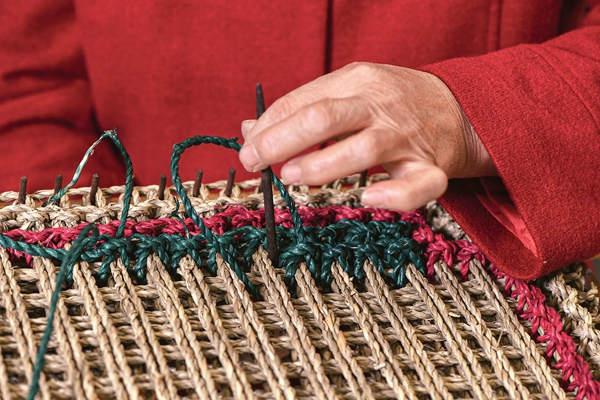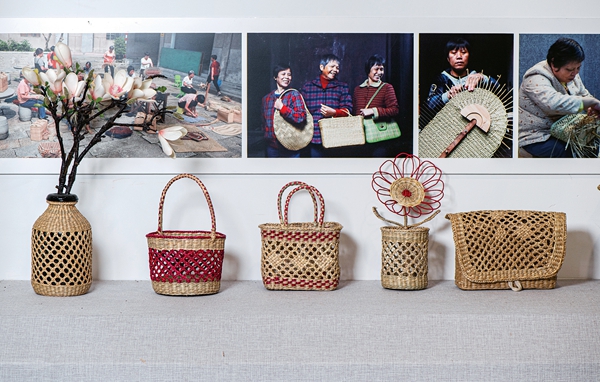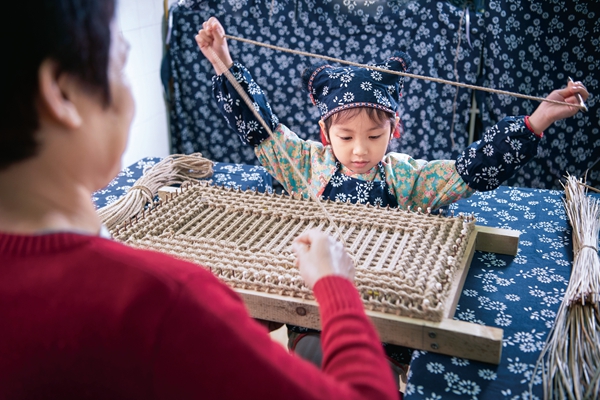Millennia-Old Weaving Technique's Resurgence in Modern Times

Guancao is a kind of aquatic plant that is flourishing in Dongguan, a coastal city in south China's Guangdong Province. Guancao-woven products, which are traditional crafts of Dongguan, have a history of more than 2,000 years. Guancao has become a cultural symbol of the city. In 2012, the guancao-weaving technique was added to the list of items of intangible cultural heritage of Guangdong Province.

Millennia-Old Treasure
Dongguan is located on the east bank of the Pearl River Estuary, where the river flows into the South China Sea. Given its geographic position, the area is suitable for the growth of guancao. It is widely believed Dongguan was named after guancao.
Guancao is pliable and tough. Dongguan residents widely used guancao in their daily lives during ancient times. Back then, the residents made net-like bags from guancao, and they used the bags to catch fish and crabs. They also used guancao to tie up and carry things, and to make thatched cottages, to keep the wind and rain out. Later, they invented handbags and mats, woven with dried strips of guancao.

The earliest existing products woven from guancao were seat cushions, which were unearthed at the world-famous Mawangdui, the grand tombs of the Marquis of Dai and his wife and son, who lived during the Han Dynasty (206 BC-220 AD). Guancao-woven products were favored by the royal family during the Han Dynasty. Documents indicate guancao-woven products were being mass produced during the early Northern and Southern dynasties (420-589).
During ancient times, Dongguan was an important city along the Maritime Silk Road, China's maritime channel for trade, communications and cultural exchanges with other countries. Guancao-woven products, a specialty of Dongguan, were exported to other countries along the Maritime Silk Road. The more popular items were sleeping mats and seat cushions. Guancao-woven products were even popular among people in Western countries during the Qing Dynasty (1616-1911) and the Republic of China (1912-1949) period.
However, the guancao-weaving industry began to wane during the 1980s, due in large part to the development and popularity of plastic products, and also due to the sharp reduction in the guancao harvest.

New Vitality
During the past few years, relevant organizations and government departments in Dongguan have made great efforts to promote the guancao-weaving technique, and guancao-woven products, and those efforts have helped rejuvenate the city's guancao-weaving industry.

For example, in Shatian, a town in Dongguan, the locals have resumed guancao, on a large scale. Shatian has also organized craftspeople to develop guancao-woven products, with aesthetic, fashionable elements, and especially to pass down the guancao-weaving technique to the next generation. A women's entrepreneurship and innovation workshop, established by the women's federation of Shatian, has helped local women, especially those in need, earn money by making guancao-woven products.
Daojiao, also a town in Donguan, for years has been committed to protecting, inheriting and innovatively developing the guancao-weaving technique, and to creating new guancao-woven products. Traditional guancao-woven products can be divided into three categories — baskets, sleeping mats and seat cushions. Local craftspeople have created new products, woven with guancao, including flowerpots, carpets, screens, chairs, handbags, cup mats, pen containers, light fittings and various toys.
In recent years, many primary and middle schools in Dongguan have set up guancao-weaving courses, to promote the guancao-weaving technique among their students. Guancao-woven products have been highlighted during intangible cultural heritage expos in China, and during expos in other countries, to promote the charm of the guancao-weaving technique.

Promoting Technique
"Guancao-woven products are pretty. I hope the guancao-weaving technique will go global," says Ye Xiaoling, an inheritor of the guancao-weaving technique. Ye, who was born in Daojiao, began learning guancao-weaving skills, from her grandmother, when she was a child. Her grandmother was skilled at making various guancao-woven products. Ye has been fond of weaving guancao since she was young. She was hired by the town's guancao-weaving factory after she graduated from high school. Years of work experience in the factory helped her develop superb guancao-weaving skills. After the guancao-weaving industry began to wane during the 1980s, Ye wrote down the guancao-weaving process, and she drew patterns of some guancao-weaving tools, to prevent the endangered guancao-weaving technique from being lost forever. In recent years, she has developed guancao-woven products, in an innovative way, and she has helped protect and revitalize the traditional guancao-weaving technique.
During recent years, Ye has been promoting and developing the guancao-weaving technique. She has participated in exhibitions, at the international, national, provincial and municipal levels, to popularize her innovative guancao-woven products, including handbags, carpets, cup mats and pen containers. She has been promoting the guancao-weaving technique on campuses, and she has been cultivating guancao-weaving talents, by organizing skills-training sessions. Ye has also provided free guancao-weaving training to disabled people, and to women in need, to help them earn a living through hard work. She has done her best to foster the resurgence of the time-honored guancao-weaving technique.
Photos by Huang Zhaijian
(Women of China English Monthly August 2024)
Editor: Wang Shasha
Please understand that womenofchina.cn,a non-profit, information-communication website, cannot reach every writer before using articles and images. For copyright issues, please contact us by emailing: website@womenofchina.cn. The articles published and opinions expressed on this website represent the opinions of writers and are not necessarily shared by womenofchina.cn.








.jpg)

 WeChat
WeChat Weibo
Weibo 京公网安备 11010102004314号
京公网安备 11010102004314号